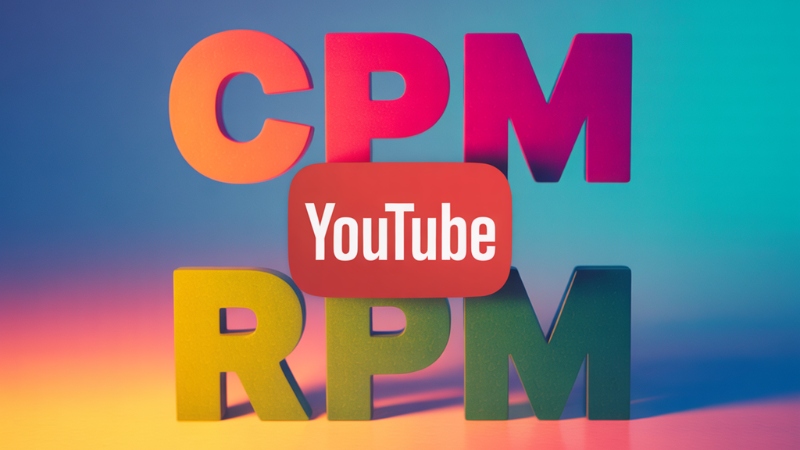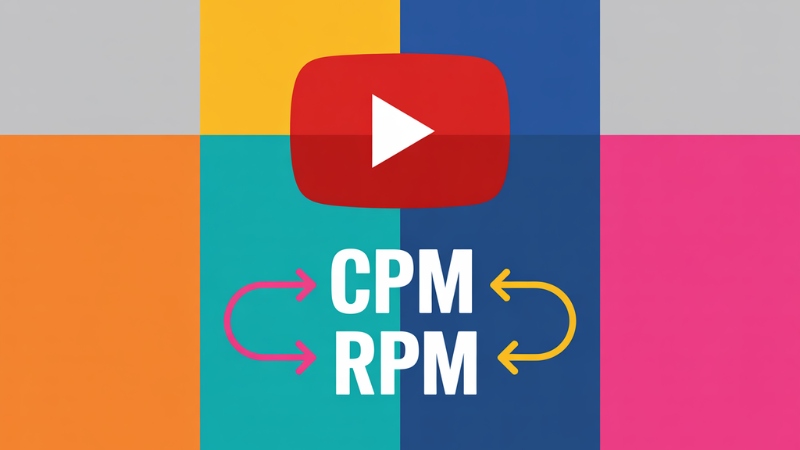What Is CPM and RPM? Understanding Your Earnings on YouTube

If you’ve ever attempted to figure out how YouTubers earn money, there’s a good chance that you are familiar with two terms often tossed around — CPM and RPM. They look like they do, but they’re measuring two completely different things. Both are necessary if you’re serious about using your channel to make money.
Let’s find out what CPM and RPM are and how they work!
What Does YouTube Pay For?
The biggest source of revenue for YouTube is ads that appear before, during, or in between videos. When companies pay YouTube to run these ads, creators get a cut of the revenue.
Here are the things you need to know -
- How many people watch your videos
- How many ads play and whether viewers skip them
- The type of content you make
- Where your viewers are located
- How long do people stay engaged with your videos?
That’s where CPM and RPM come in. They help you understand how your views translate into money.
What Is CPM?
CPM stands for Cost Per Mille – millie is the Latin word for thousand, so cost per thousand. This is the amount advertisers pay for every 1,000 times the ad is shown!
But there’s a catch — CPM is based on what advertisers pay you, not what you make.
Assuming your CPM is $6, that means advertisers pay YouTube $6 for 1,000 views of their advertisements on your videos. After YouTube takes its cut, you’ll get only a fraction of that.
Things that affect your CPM:
- Audience location: Generally, ads targeting people in countries like the U.S., Canada, and the U.K. are more expensive.
- Video topic: Finance, tech, and business videos attract better-paying ads than even moderate entertainment.
- Periodic demand: Advertisers pay seasonally, whether that is around holidays or mere shopping seasons.
- Engagement: The longer your videos hold viewers’ attention, the more valuable ads you can space.
Likewise, consider CPM as the budget of the advertiser. It illustrates how much those brands think your video space is worth.
What Is RPM?
RPM stands for Revenue Per Mille (forgive me for being Captain Obvious), but it’s how much you’re actually making per 1,000 views after YouTube takes its share. If CPM is what advertisers pay, then RPM is what you receive.
For instance, if the CPM is $6, almost 50% of that goes to YouTube, and then you are left with around 3$. That means you make $3 per 1,000 views.
RPM includes all your YouTube earnings — not just from ads, but also from:
- YouTube Premium (subscription revenue)
- Channel memberships
- Super Chats and Super Stickers
- Merchandise shelf sales
So, RPM provides a fuller picture of your total revenue per 1,000 views.
In short:
- CPM = What advertisers pay YouTube
- RPM = What you actually earn
Why Do CPM and RPM Change So Often?
A lot of creators see their CPM or RPM all over the place, from video to video and month to month. This happens for several reasons:
1. Ad budgets rise and fall. Companies spend more on advertising during big shopping times, like during Black Friday or in December at Christmas.
2. Viewer location changes. If suddenly most of your views come from low-paying countries, then your CPM will decrease.
3. Video topics vary. A tech tutorial might get higher CPM than a casual vlog.
4. Viewer engagement differs. If people skip ads quickly, ad revenue decreases.
5. Video length matters. Longer videos allow multiple ads, which can increase earnings.
So if you see a drop in your CPM or RPM at some point, don’t worry — there’s nothing to be alarmed about.
How to Increase Your CPM and RPM

You can’t control every factor, but there are smart tactics for improving both metrics.
1. Choose a high-paying niche.
Advertisers pay the highest for the topics that engage the most viewers. Popular high-CPM niches include:
- Finance and investing
- Business and marketing
- Technology and software
- Health and wellness
- Education and self-improvement
2. Focus on audience location.
Try to attract viewers from countries with higher ad spending. Adding English subtitles or using globally relevant topics can help.
3. Make videos longer than eight minutes.
YouTube allows multiple mid-roll ads for videos over eight minutes, which increases total ad revenue.
4. Improve viewer retention.
When people watch more of your videos, YouTube also gives you improved placement of ads. Strive for quality content that fosters user retention.
5. Stay advertiser-friendly.
Avoid conflicting or touchy subjects, as that would allow monetization. Advertisers prefer clean, family-friendly videos.
6. Use both trending and evergreen content.
Trends give quick traffic boosts, while evergreen videos (like tutorials or reviews) keep earning for months.
7. Analyze your analytics.
You should see which videos are getting the highest CPM and RPM. Study their titles, topics, and formats — then mimic what works best.
Why Choose MoreThanPanel
MoreThanPanel can help you gain safe visibility and engagement, so that you will not have to spend much time promoting your videos. It’s one of the most reliable social media growth tools for 2025. Unfortunately, there are too many scams out there claiming they offer an Instagram follower service.
Here’s why creators rely on it:
- Rapid: Rapid delivery of views, likes, and subscribers.
- Plans for any budget: Options that fit any creator’s budget.
- True engagement: Organic growth that boosts reach.
- Single-dashboard access: You can manage YouTube, TikTok, and Instagram via one dashboard.
- 24/7 customer support: Always available to help.
Using a slow but steady approach together with very strong viewer involvement, your channel can reach more people — that is, the CPM and RPM will gradually go up to a higher level than ever.
Final Thoughts
Going beyond mere numbers, CPM and RPM — these two indicators can provide you with a vital hint as to content monetization.
Continue to focus on making engaging videos that would attract advertisers, finding the right audience, and keeping them interested to earn more. In the long run, these habits result in greater revenue and more impact on YouTube.
Mix creativity with discipline and shrewd strategy — and you, too, can transform your channel into a steady source of revenue while working from home one video at a time.


